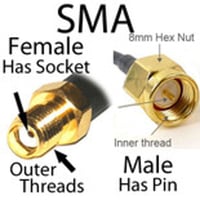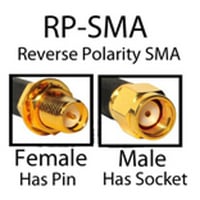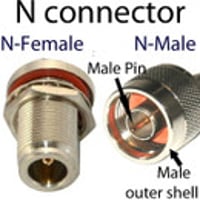5G Antennas: 698 MHz to 6GHz
5G Antennas: Types, Connector Types, Specifications
Key Features
- Enhanced Bandwidth: 5G antennas support much broader bandwidths than previous generation antennas, facilitating faster data rates.
- Massive MIMO: They leverage Massive Multiple Input, Multiple Output technology, utilizing multiple antennas to enhance signal and reduce interference.
- Beamforming: This feature allows 5G antennas to focus the radio wave signal directionally, improving efficiency and signal strength.
- Flexibility: Many 5G antennas can dynamically adjust their radiation patterns, ensuring optimal signal quality regardless of device orientation or location.
Typical Antenna Connectors
The rapidly evolving 5G technology brings in an array of connectors for various applications. Some typical antenna connectors include:
- SMA: A versatile and commonly used connector in RF applications.
- N-type: Known for high power handling capacities, ideal for base station applications.
- QMA & MQ4/MQ5: Quick-connect solutions predominantly used in infrastructure equipment.
- U.FL & MHF: Miniature connectors mostly seen in embedded devices due to their small form factor.
Torque Ratings of the Antenna Connectors
Ensuring a proper and consistent connection is paramount for optimal 5G performance. The torque values provide guidance for this:
- SMA: Typically around 3-5 in-lbs for hand tightening.
- N-type: Generally recommended at 12-15 in-lbs when using a torque wrench.
- QMA: Roughly 2-3 in-lbs.
- Other connectors, especially miniature ones like U.FL, require gentle hand tightening without specific torque values.
Types and Typical Materials Composition
- Monopole Antennas: Often made of conductive metals like copper or aluminum, they're simple in design and provide omni-directional radiation patterns.
- Dipole Antennas: Consisting of two conductive elements, typically made of metals like copper, they offer a broader bandwidth than monopoles.
- Patch Antennas: These are flat and rectangular, often made of a metal plate (like copper) placed over a ground plane. They are directional.
- MIMO Antennas: Leveraging multiple antennas in one unit, they are often composed of multiple patch or dipole antennas and corresponding circuitry.
- Phased Array Antennas: Used in beamforming, these are often made up of multiple tiny antenna elements on a single plate, frequently made of conductive materials like gold, silver, or copper, depending on the design.
Unleashing the Full Potential of 5G
Exploring Frequency Bands and Cutting-Edge Applications
Introduction: The advent of 5G technology has ushered in a new era of connectivity, promising lightning-fast speeds, ultra-low latency, and a transformative impact on various industries. At the heart of this technological leap lies the intricate interplay between 5G frequency bands and the groundbreaking applications they enable. In this comprehensive article, we will delve deep into the realm of 5G frequency bands, exploring their characteristics, advantages, and challenges. Additionally, we will uncover the game-changing applications that set 5G apart from its predecessor, 4G, and the revolutionary potential it holds for wireless communication.
Understanding 5G Frequency Bands: A Spectrum of Possibilities
To comprehend the true power of 5G, it is crucial to understand the spectrum resources it utilizes. Let's explore the various 5G frequency bands in detail, including low-band, mid-band, and high-band (mmWave). Each band offers distinct characteristics, advantages, and challenges, making them suitable for different use cases and applications. By examining the properties and deployment strategies of these frequency bands, we can gain a deeper understanding of the spectrum revolution that underpins the extraordinary capabilities of 5G technology.
Low-Band: Extensive Coverage and Stable Connectivity
The low-band frequency, operating below 1 GHz, provides wide coverage and reliable connectivity. While it offers modest data speeds compared to other bands, it excels in penetrating buildings and obstacles, making it ideal for providing ubiquitous coverage in urban areas and rural landscapes. The low-band is particularly beneficial for applications requiring long-range connectivity, such as IoT devices and critical infrastructure monitoring.
Mid-Band: Balancing Speed and Coverage
The mid-band frequency, ranging from 1 GHz to 6 GHz, strikes a balance between coverage and data speeds. With improved capacity and faster speeds than the low-band, it enables applications such as high-definition video streaming, augmented reality (AR), and virtual reality (VR) experiences. The mid-band is considered the "Goldilocks" band, offering a sweet spot for both coverage and capacity, making it crucial for delivering enhanced mobile broadband (eMBB) services.
High-Band (mmWave): Unleashing Gigabit Speeds
The high-band frequency, also known as millimeter-wave (mmWave), operates in the range of 24 GHz to 100 GHz. It boasts the potential for blazing-fast speeds, reaching several gigabits per second. However, the high-band's limited range and susceptibility to obstacles pose challenges for widespread deployment. Despite these challenges, mmWave technology opens the doors to revolutionary applications such as ultra-high-definition video streaming, real-time cloud gaming, and massive machine-type communication (mMTC).
Revolutionary 5G Applications: Transforming Industries and Enhancing Lives
One of the key differentiators of 5G is its ability to support a vast array of innovative applications that were previously unimaginable. Let's explore how 5G applications revolutionize industries and enhance everyday life, surpassing the limitations of 4G technology.
Enhanced Mobile Broadband (eMBB): Unleashing Multimedia Experiences
5G's eMBB capabilities provide lightning-fast speeds and low latency, enabling seamless multimedia experiences on mobile devices. From 4K video streaming to immersive AR and VR applications, eMBB transforms the way we consume content, pushing the boundaries of entertainment, education, and communication.
Ultra-Reliable Low-Latency Communication (URLLC): Enabling Mission-Critical Services
URLLC is a game-changer for applications that demand ultra-low latency and high reliability. Industries such as healthcare, transportation, and manufacturing benefit from real-time monitoring, remote surgeries, autonomous vehicles, and industrial automation. With URLLC, 5G paves the way for mission-critical services that can save lives, improve efficiency, and enhance safety.
Massive Machine-Type Communication (mMTC): Connecting the Internet of Things (IoT)
The proliferation of IoT devices requires a network that can handle massive connectivity demands. 5G's mMTC capabilities enable seamless communication between countless IoT devices, facilitating smart cities, smart homes, industrial IoT, and agricultural automation. With mMTC, 5G provides the foundation for a hyper-connected world, enabling efficient data transfer, intelligent decision-making, and resource optimization.
Fixed Wireless Access (FWA): Broadband Connectivity Without Cables
FWA leverages 5G technology to deliver high-speed broadband connectivity without the need for physical cables. It enables households and businesses in underserved areas to access reliable internet connectivity, bridging the digital divide. FWA serves as a cost-effective alternative to traditional wired connections, offering flexibility, scalability, and faster deployment.
Harnessing the Power of 5G: Real-World Examples and Future Possibilities
In this section, we will delve into real-world examples of 5G applications that are already transforming industries and paving the way for future possibilities.
Smart Cities: Creating Intelligent Urban Environments
With 5G connectivity, smart cities leverage IoT devices, sensors, and real-time data to enhance urban living. Smart traffic management, intelligent energy grids, efficient waste management, and public safety initiatives are just a few examples of how 5G transforms cities into sustainable, connected ecosystems, improving the quality of life for residents.
Autonomous Vehicles: Redefining Transportation
5G enables the seamless communication and data exchange required for autonomous vehicles. From self-driving cars and trucks to smart transportation infrastructure, 5G's low latency and high reliability are critical for enabling real-time decision-making, enhancing road safety, and optimizing traffic flow.
Telemedicine: Revolutionizing Healthcare
With 5G, telemedicine gains new dimensions. Remote consultations, telemonitoring, and real-time patient data exchange enable healthcare providers to deliver high-quality care to patients regardless of their location. From remote diagnosis to surgical assistance, 5G empowers healthcare professionals to save lives and provide specialized care efficiently.
Immersive Augmented Reality (AR) and Virtual Reality (VR): Redefining Experiences
5G's high-speed and low-latency capabilities unlock the full potential of AR and VR experiences. From immersive gaming to virtual meetings, 5G-enabled AR and VR applications offer users a heightened sense of presence and interactivity, transforming entertainment, education, and professional collaborations.
Industrial Automation: Boosting Productivity and Efficiency
Industries such as manufacturing and logistics benefit from 5G's ability to enable real-time control and monitoring of machines and processes. With ultra-low latency and high reliability, 5G empowers factories to optimize production, reduce downtime, and improve overall efficiency. From predictive maintenance to autonomous robots, 5G revolutionizes industrial automation.
Conclusion:
As we conclude our exploration, it becomes evident that 5G frequency bands and their revolutionary applications have the potential to reshape the way we connect, communicate, and interact with technology. The diverse spectrum resources of 5G, coupled with its transformative applications, open up a world of possibilities, driving us towards a future where connectivity knows no bounds.
At Data Alliance, we understand the importance of providing comprehensive solutions for your 5G projects. Whether you are in need of products related to 5G frequency bands or have any questions regarding these products, we are here to assist you. Our dedicated team is ready to address your inquiries, offer guidance, and ensure that you have the right products to meet your specific requirements.
Feel free to contact us with any product needs or questions you may have. We are here to serve you and provide the support you need to make your projects a resounding success.







